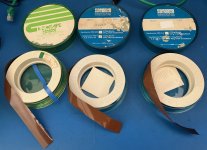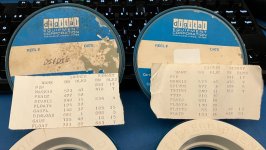NF6X
Veteran Member
I recently got three DECtape reels from eBay auctions. One is in a green LINCtape case, and the other two are in blue DECtape cases. I seem to recall reading that DECtape and LINCtape have opposite conventions for which sides the supply and takeup reels go on. All three of my tapes are wound counterclockwise, such that (I think...) the supply reel would mount on the right spindle. Does that imply that all three of my tapes are probably LINCtapes? Can both DECtape and LINCtape reels be read on any PDP-xx system with a TU-5x transport and matching controller?




